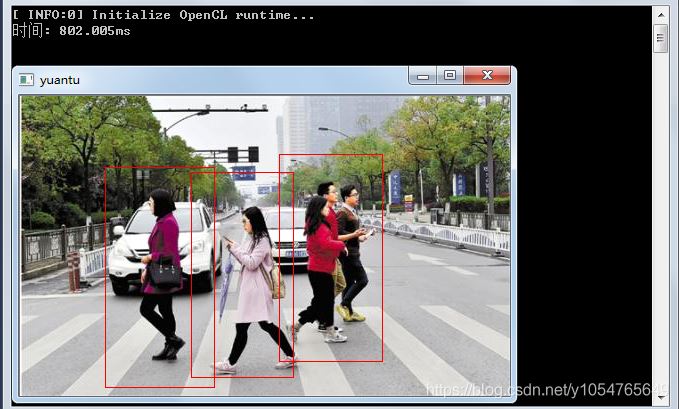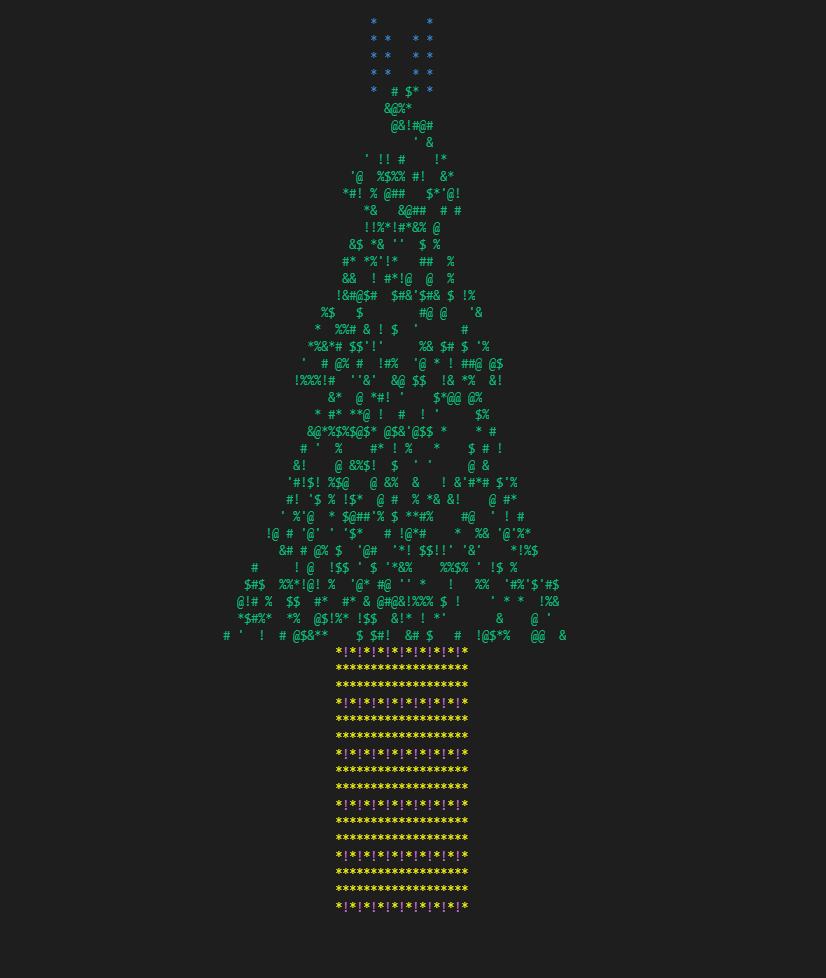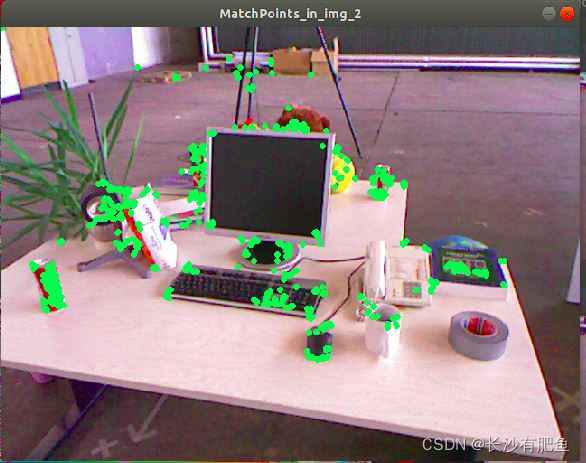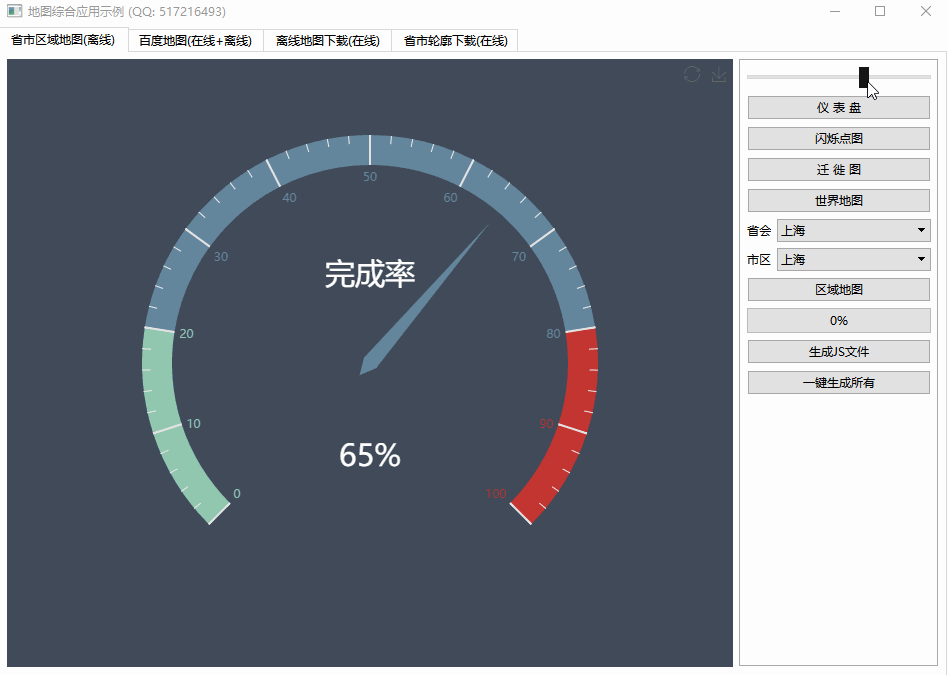OpenCV Orb not finding matches once rotation/scale invariances are introduced(引入旋转/缩放不变性后,OpenCV Orb 找不到匹配项)
问题描述
我正在使用 OpenCV 2.3.1 中的 Orb 特征检测器进行项目.我找到了 8 张不同图像之间的匹配,其中 6 张非常相似(相机位置相差 20 厘米,沿着线性滑块,因此没有比例或旋转变化),然后从大约 45 度角拍摄的 2 张图像来自边.我的代码在非常相似的图像之间找到了大量准确的匹配,但对于从更不同的角度拍摄的图像,几乎没有.我已经包含了我认为代码的相关部分,如果您需要更多信息,请告诉我.
I am working on a project using the Orb feature detector in OpenCV 2.3.1 . I am finding matches between 8 different images, 6 of which are very similar (20 cm difference in camera position, along a linear slider so there is no scale or rotational variance), and then 2 images taken from about a 45 degree angle from either side. My code is finding plenty of accurate matches between the very similar images, but few to none for the images taken from a more different perspective. I've included what I think are the pertinent parts of my code, please let me know if you need more information.
// set parameters
int numKeyPoints = 1500;
float distThreshold = 15.0;
//instantiate detector, extractor, matcher
detector = new cv::OrbFeatureDetector(numKeyPoints);
extractor = new cv::OrbDescriptorExtractor;
matcher = new cv::BruteForceMatcher<cv::HammingLUT>;
//Load input image detect keypoints
cv::Mat img1;
std::vector<cv::KeyPoint> img1_keypoints;
cv::Mat img1_descriptors;
cv::Mat img2;
std::vector<cv::KeyPoint> img2_keypoints
cv::Mat img2_descriptors;
img1 = cv::imread(fList[0].string(), CV_LOAD_IMAGE_GRAYSCALE);
img2 = cv::imread(fList[1].string(), CV_LOAD_IMAGE_GRAYSCALE);
detector->detect(img1, img1_keypoints);
detector->detect(img2, img2_keypoints);
extractor->compute(img1, img1_keypoints, img1_descriptors);
extractor->compute(img2, img2_keypoints, img2_descriptors);
//Match keypoints using knnMatch to find the single best match for each keypoint
//Then cull results that fall below given distance threshold
std::vector<std::vector<cv::DMatch> > matches;
matcher->knnMatch(img1_descriptors, img2_descriptors, matches, 1);
int matchCount=0;
for (int n=0; n<matches.size(); ++n) {
if (matches[n].size() > 0){
if (matches[n][0].distance > distThreshold){
matches[n].erase(matches[n].begin());
}else{
++matchCount;
}
}
}
推荐答案
通过更改过滤匹配的流程,我最终获得了足够多的有用匹配.我以前的方法是仅根据它们的距离值丢弃很多好的匹配项.我在 OpenCV2 计算机视觉应用程序编程手册中找到的这个 RobustMatcher 类最终运行良好.现在我的所有匹配都准确无误,通过增加 ORB 检测器正在寻找的关键点的数量,我已经能够获得足够好的结果.将 RobustMatcher 与 SIFT 或 SURF 结合使用仍能提供更好的结果,但我现在使用 ORB 获得了可用数据.
I ended up getting enough useful matches by changing my process for filtering matches. My previous method was discarding a lot of good matches based solely on their distance value. This RobustMatcher class that I found in the OpenCV2 Computer Vision Application Programming Cookbook ended up working great. Now that all of my matches are accurate, I've been able to get good enough results by bumping up the number of keypoints that the ORB detector is looking. Using the RobustMatcher with SIFT or SURF still gives much better results, but I'm getting usable data with ORB now.
//RobustMatcher class taken from OpenCV2 Computer Vision Application Programming Cookbook Ch 9
class RobustMatcher {
private:
// pointer to the feature point detector object
cv::Ptr<cv::FeatureDetector> detector;
// pointer to the feature descriptor extractor object
cv::Ptr<cv::DescriptorExtractor> extractor;
// pointer to the matcher object
cv::Ptr<cv::DescriptorMatcher > matcher;
float ratio; // max ratio between 1st and 2nd NN
bool refineF; // if true will refine the F matrix
double distance; // min distance to epipolar
double confidence; // confidence level (probability)
public:
RobustMatcher() : ratio(0.65f), refineF(true),
confidence(0.99), distance(3.0) {
// ORB is the default feature
detector= new cv::OrbFeatureDetector();
extractor= new cv::OrbDescriptorExtractor();
matcher= new cv::BruteForceMatcher<cv::HammingLUT>;
}
// Set the feature detector
void setFeatureDetector(
cv::Ptr<cv::FeatureDetector>& detect) {
detector= detect;
}
// Set the descriptor extractor
void setDescriptorExtractor(
cv::Ptr<cv::DescriptorExtractor>& desc) {
extractor= desc;
}
// Set the matcher
void setDescriptorMatcher(
cv::Ptr<cv::DescriptorMatcher>& match) {
matcher= match;
}
// Set confidence level
void setConfidenceLevel(
double conf) {
confidence= conf;
}
//Set MinDistanceToEpipolar
void setMinDistanceToEpipolar(
double dist) {
distance= dist;
}
//Set ratio
void setRatio(
float rat) {
ratio= rat;
}
// Clear matches for which NN ratio is > than threshold
// return the number of removed points
// (corresponding entries being cleared,
// i.e. size will be 0)
int ratioTest(std::vector<std::vector<cv::DMatch> >
&matches) {
int removed=0;
// for all matches
for (std::vector<std::vector<cv::DMatch> >::iterator
matchIterator= matches.begin();
matchIterator!= matches.end(); ++matchIterator) {
// if 2 NN has been identified
if (matchIterator->size() > 1) {
// check distance ratio
if ((*matchIterator)[0].distance/
(*matchIterator)[1].distance > ratio) {
matchIterator->clear(); // remove match
removed++;
}
} else { // does not have 2 neighbours
matchIterator->clear(); // remove match
removed++;
}
}
return removed;
}
// Insert symmetrical matches in symMatches vector
void symmetryTest(
const std::vector<std::vector<cv::DMatch> >& matches1,
const std::vector<std::vector<cv::DMatch> >& matches2,
std::vector<cv::DMatch>& symMatches) {
// for all matches image 1 -> image 2
for (std::vector<std::vector<cv::DMatch> >::
const_iterator matchIterator1= matches1.begin();
matchIterator1!= matches1.end(); ++matchIterator1) {
// ignore deleted matches
if (matchIterator1->size() < 2)
continue;
// for all matches image 2 -> image 1
for (std::vector<std::vector<cv::DMatch> >::
const_iterator matchIterator2= matches2.begin();
matchIterator2!= matches2.end();
++matchIterator2) {
// ignore deleted matches
if (matchIterator2->size() < 2)
continue;
// Match symmetry test
if ((*matchIterator1)[0].queryIdx ==
(*matchIterator2)[0].trainIdx &&
(*matchIterator2)[0].queryIdx ==
(*matchIterator1)[0].trainIdx) {
// add symmetrical match
symMatches.push_back(
cv::DMatch((*matchIterator1)[0].queryIdx,
(*matchIterator1)[0].trainIdx,
(*matchIterator1)[0].distance));
break; // next match in image 1 -> image 2
}
}
}
}
// Identify good matches using RANSAC
// Return fundemental matrix
cv::Mat ransacTest(
const std::vector<cv::DMatch>& matches,
const std::vector<cv::KeyPoint>& keypoints1,
const std::vector<cv::KeyPoint>& keypoints2,
std::vector<cv::DMatch>& outMatches) {
// Convert keypoints into Point2f
std::vector<cv::Point2f> points1, points2;
cv::Mat fundemental;
for (std::vector<cv::DMatch>::
const_iterator it= matches.begin();
it!= matches.end(); ++it) {
// Get the position of left keypoints
float x= keypoints1[it->queryIdx].pt.x;
float y= keypoints1[it->queryIdx].pt.y;
points1.push_back(cv::Point2f(x,y));
// Get the position of right keypoints
x= keypoints2[it->trainIdx].pt.x;
y= keypoints2[it->trainIdx].pt.y;
points2.push_back(cv::Point2f(x,y));
}
// Compute F matrix using RANSAC
std::vector<uchar> inliers(points1.size(),0);
if (points1.size()>0&&points2.size()>0){
cv::Mat fundemental= cv::findFundamentalMat(
cv::Mat(points1),cv::Mat(points2), // matching points
inliers, // match status (inlier or outlier)
CV_FM_RANSAC, // RANSAC method
distance, // distance to epipolar line
confidence); // confidence probability
// extract the surviving (inliers) matches
std::vector<uchar>::const_iterator
itIn= inliers.begin();
std::vector<cv::DMatch>::const_iterator
itM= matches.begin();
// for all matches
for ( ;itIn!= inliers.end(); ++itIn, ++itM) {
if (*itIn) { // it is a valid match
outMatches.push_back(*itM);
}
}
if (refineF) {
// The F matrix will be recomputed with
// all accepted matches
// Convert keypoints into Point2f
// for final F computation
points1.clear();
points2.clear();
for (std::vector<cv::DMatch>::
const_iterator it= outMatches.begin();
it!= outMatches.end(); ++it) {
// Get the position of left keypoints
float x= keypoints1[it->queryIdx].pt.x;
float y= keypoints1[it->queryIdx].pt.y;
points1.push_back(cv::Point2f(x,y));
// Get the position of right keypoints
x= keypoints2[it->trainIdx].pt.x;
y= keypoints2[it->trainIdx].pt.y;
points2.push_back(cv::Point2f(x,y));
}
// Compute 8-point F from all accepted matches
if (points1.size()>0&&points2.size()>0){
fundemental= cv::findFundamentalMat(
cv::Mat(points1),cv::Mat(points2), // matches
CV_FM_8POINT); // 8-point method
}
}
}
return fundemental;
}
// Match feature points using symmetry test and RANSAC
// returns fundemental matrix
cv::Mat match(cv::Mat& image1,
cv::Mat& image2, // input images
// output matches and keypoints
std::vector<cv::DMatch>& matches,
std::vector<cv::KeyPoint>& keypoints1,
std::vector<cv::KeyPoint>& keypoints2) {
// 1a. Detection of the SURF features
detector->detect(image1,keypoints1);
detector->detect(image2,keypoints2);
// 1b. Extraction of the SURF descriptors
cv::Mat descriptors1, descriptors2;
extractor->compute(image1,keypoints1,descriptors1);
extractor->compute(image2,keypoints2,descriptors2);
// 2. Match the two image descriptors
// Construction of the matcher
//cv::BruteForceMatcher<cv::L2<float>> matcher;
// from image 1 to image 2
// based on k nearest neighbours (with k=2)
std::vector<std::vector<cv::DMatch> > matches1;
matcher->knnMatch(descriptors1,descriptors2,
matches1, // vector of matches (up to 2 per entry)
2); // return 2 nearest neighbours
// from image 2 to image 1
// based on k nearest neighbours (with k=2)
std::vector<std::vector<cv::DMatch> > matches2;
matcher->knnMatch(descriptors2,descriptors1,
matches2, // vector of matches (up to 2 per entry)
2); // return 2 nearest neighbours
// 3. Remove matches for which NN ratio is
// > than threshold
// clean image 1 -> image 2 matches
int removed= ratioTest(matches1);
// clean image 2 -> image 1 matches
removed= ratioTest(matches2);
// 4. Remove non-symmetrical matches
std::vector<cv::DMatch> symMatches;
symmetryTest(matches1,matches2,symMatches);
// 5. Validate matches using RANSAC
cv::Mat fundemental= ransacTest(symMatches,
keypoints1, keypoints2, matches);
// return the found fundemental matrix
return fundemental;
}
};
// set parameters
int numKeyPoints = 1500;
//Instantiate robust matcher
RobustMatcher rmatcher;
//instantiate detector, extractor, matcher
detector = new cv::OrbFeatureDetector(numKeyPoints);
extractor = new cv::OrbDescriptorExtractor;
matcher = new cv::BruteForceMatcher<cv::HammingLUT>;
rmatcher.setFeatureDetector(detector);
rmatcher.setDescriptorExtractor(extractor);
rmatcher.setDescriptorMatcher(matcher);
//Load input image detect keypoints
cv::Mat img1;
std::vector<cv::KeyPoint> img1_keypoints;
cv::Mat img1_descriptors;
cv::Mat img2;
std::vector<cv::KeyPoint> img2_keypoints
cv::Mat img2_descriptors;
std::vector<std::vector<cv::DMatch> > matches;
img1 = cv::imread(fList[0].string(), CV_LOAD_IMAGE_GRAYSCALE);
img2 = cv::imread(fList[1].string(), CV_LOAD_IMAGE_GRAYSCALE);
rmatcher.match(img1, img2, matches, img1_keypoints, img2_keypoints);
这篇关于引入旋转/缩放不变性后,OpenCV Orb 找不到匹配项的文章就介绍到这了,希望我们推荐的答案对大家有所帮助,也希望大家多多支持编程学习网!
本文标题为:引入旋转/缩放不变性后,OpenCV Orb 找不到匹配项


- XML Schema 到 C++ 类 2022-01-01
- 哪个更快:if (bool) 或 if(int)? 2022-01-01
- 将函数的返回值分配给引用 C++? 2022-01-01
- 使用 __stdcall & 调用 DLLVS2013 中的 GetProcAddress() 2021-01-01
- DoEvents 等效于 C++? 2021-01-01
- 从父 CMakeLists.txt 覆盖 CMake 中的默认选项(...)值 2021-01-01
- 如何提取 __VA_ARGS__? 2022-01-01
- OpenGL 对象的 RAII 包装器 2021-01-01
- GDB 不显示函数名 2022-01-01
- 将 hdc 内容复制到位图 2022-09-04





